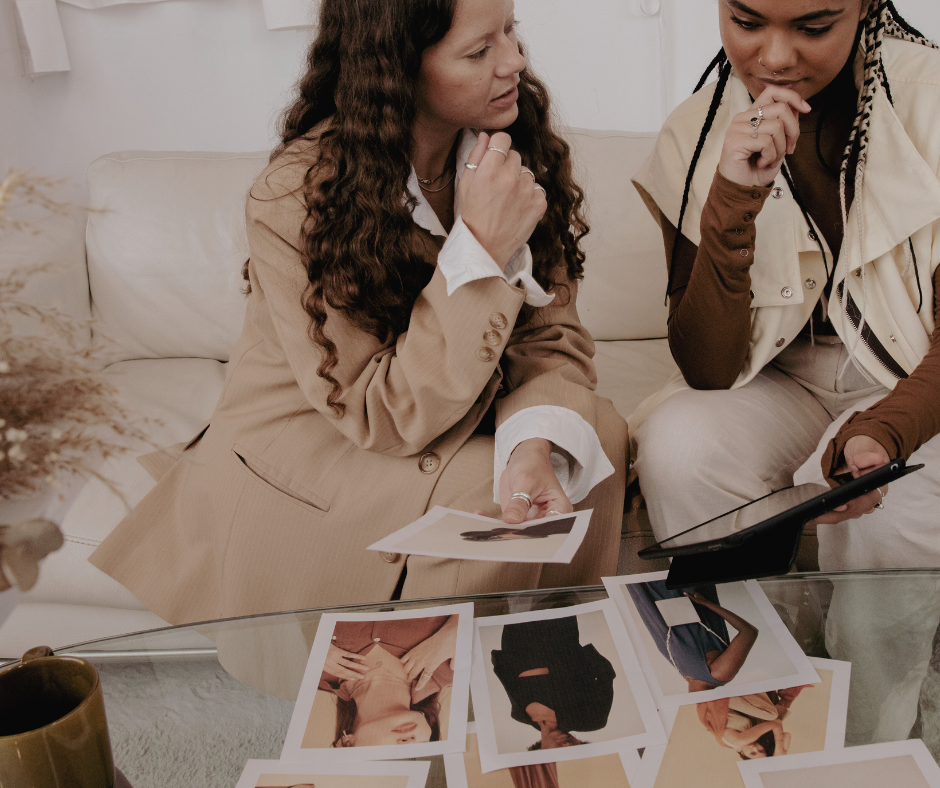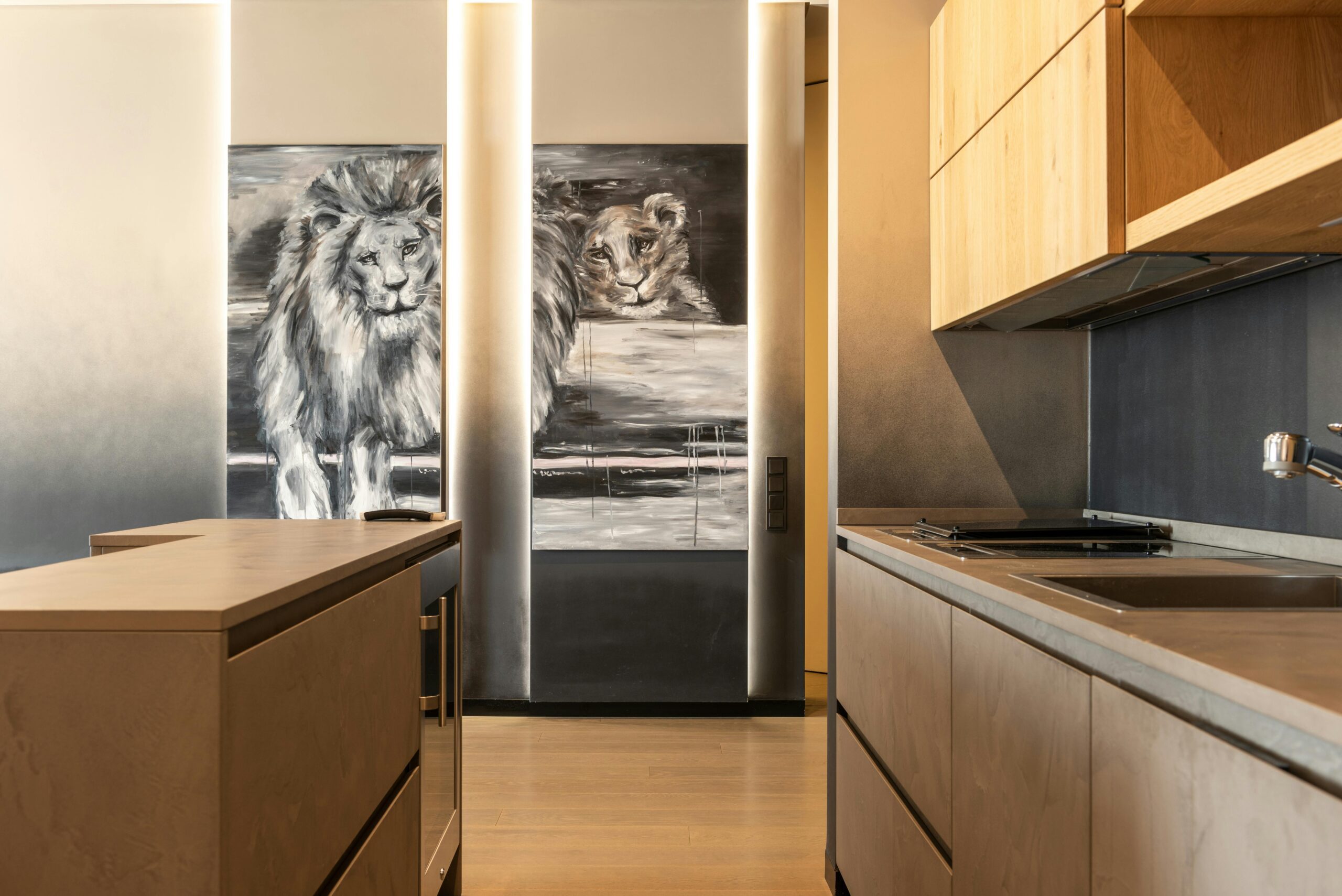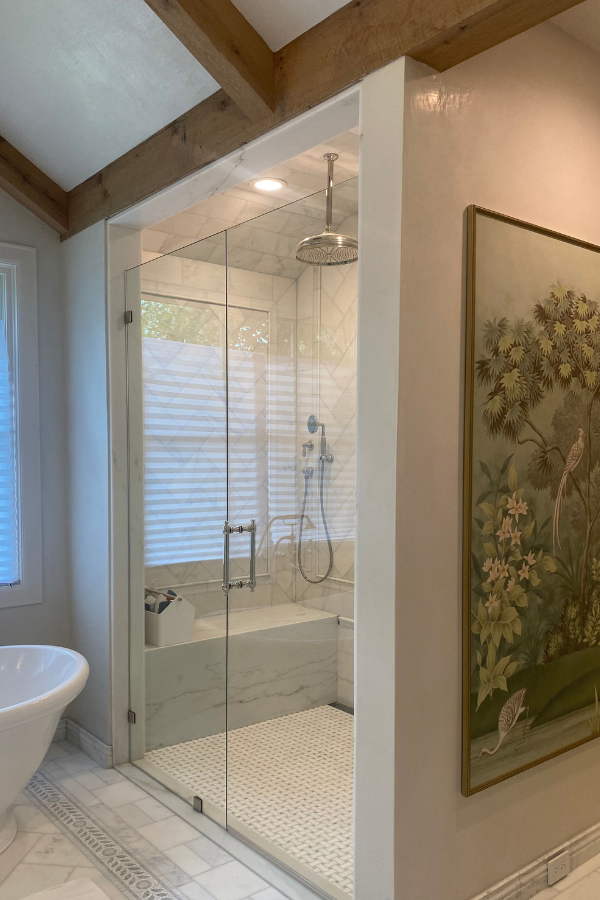
Can You Hang Art in Your Bathroom? Here’s the Long & Short of It.
Summary
Yes, you can hang art in your bathroom—but not just any art. Avoid paper-based works, unsealed canvases, and mixed-media pieces unless your space is extremely well-ventilated. Instead, look for ceramics, glass, and properly framed or professionally mounted works that can withstand humidity. Your powder room deserves beauty—but let it be curated with care.
Reflection Questions
What’s one piece of art you love that might be at risk in your current bathroom setup?
How might you use sculptural objects to add personality without compromising durability?
Would rotating your bathroom artwork seasonally change how the space feels throughout the year?
Journal Prompt
Describe your bathroom as it is now. What would it feel like to transform it into a gallery space—not just functional, but contemplative and beautiful? What would you hang (or place) if there were no constraints?
While steamy showers and fluctuating temperatures can quietly damage certain materials over time, not all artwork is created equal—and not all bathrooms are equally harsh. With the right materials, framing techniques, and placement strategies, you can absolutely bring beauty into powder rooms (and some full baths). From ceramic wall sculptures to carefully sealed prints, the key is knowing what will thrive and what might deteriorate when exposed to moisture. Below, we unpack which types of art are safe, which to avoid, and how to style your bathroom with confidence—and conservation in mind.
What’s the Harm in Hanging Art in Your Bathroom?
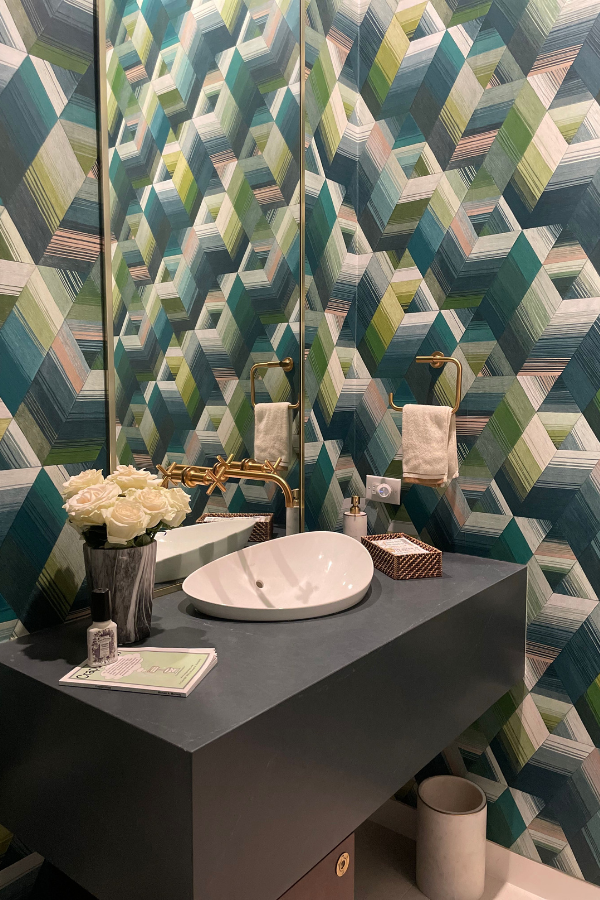
According to Architectural Digest, bathrooms can absolutely be places of beauty, but they’re not without hazards. High humidity, inconsistent ventilation, and temperature fluctuations can be quiet destroyers. Paper-based artwork—photographs, watercolors, drawings—are especially vulnerable to warping, foxing (those tiny brown spots caused by moisture), and mold. Even oils and acrylics, while more resilient, can soften or crack under constant climate shifts common in a bathroom space. However, every work is different and preparation plays a major role.
Conservators Warn Against Placing Paintings and Works on Paper in Humid Spaces
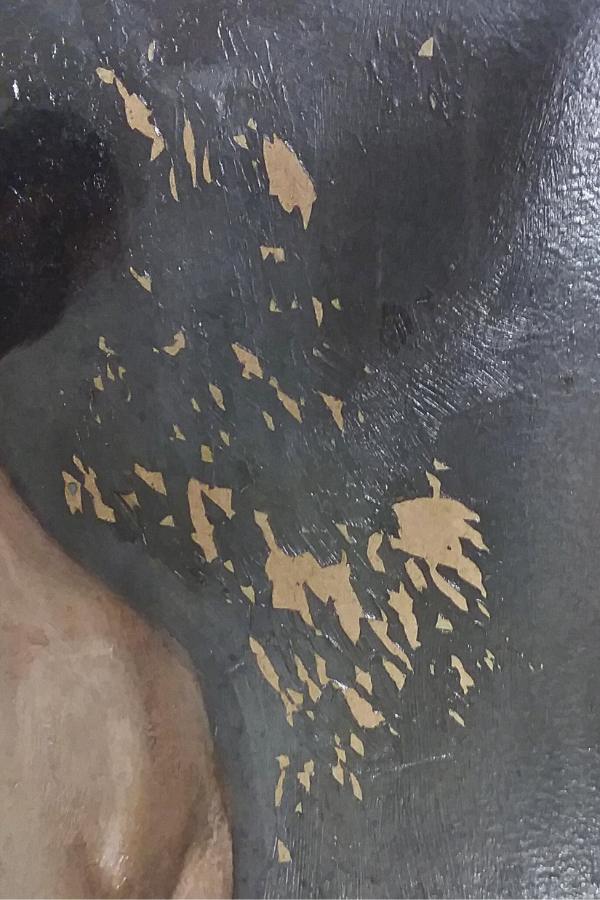
That’s not just a decorator’s superstition—it’s museum science. As outlined in conservation guidelines, the risk of deterioration in artworks spikes dramatically when the relative humidity (RH) veers outside a narrow window. Most bathrooms, especially without robust ventilation or a window, can climb well beyond 70% RH after a single hot shower. Over time, this opens the door to mold, warping, and delamination, particularly in works on paper or wood.
Conservator Elizabeth Burton—owner and head conservator at Central Coast Painting Conservation in California—elaborates. While powder baths can be fine, she warns against hanging delicate paintings in spaces that reach dew point humidity.
“Swings in relative humidity can weaken the adhesion between paint layers and substrate (canvas, wood, metal panel, etc.). This is especially concerning when that relationship is already tenuous—think unprimed Masonite with thickly applied oil paint impasto—or when the substrate flexes in response to exposure.” Where else should you avoid mounting artwork? “Above fireplaces and underneath vents,” she says. “But understanding the condition of the work is most important.”
But What Exactly Happens to Different Types of Art in Humid Conditions?
Paper-Based Works (Drawings, Prints, Photography)

These are the most sensitive to moisture. Paper fibers swell and contract with changes in humidity, leading to buckling, rippling, or tearing. Mold can grow in the microscopic crevices of the paper, especially behind glass. Foxing is common—and generally irreversible (though it can be reduced).
Even photographs printed on fiber-based paper are susceptible to silver mirroring and fading when RH isn’t controlled.
Paintings on Canvas or Wood Panel
While oils and acrylics are more robust than paper, they’re far from immune. Canvas can expand and sag when exposed to humidity, which destabilizes the paint film. On rigid substrates like wood, especially thin or unsealed panels, moisture can cause cupping, warping, or delamination of paint.
Cracking, known as cleavage or tenting, may form where paint no longer adheres securely.
Metal and Mixed-Media Pieces

Metal elements can corrode or oxidize. Works with layered materials—think collage, textiles, or found object art—may react unevenly, with some components swelling, others shrinking, and adhesives failing altogether. Don’t put your favorite works in the bathroom; consider inexpensive pieces, those made of durable materials or simply move them into the other room.
Unframed or Poorly Framed Works
Humidity enters from the back and sides of unprotected artwork. Even framed pieces are at risk if they lack archival backing boards, sealed corners, and spacers to lift the artwork away from glazing. The picture frames themselves can suffer if you display art in your bathroom. Condensation trapped between glass and artwork is especially damaging—it’s like sealing your art inside a cloud.
Ceramics and Glass (They’re Near-Perfect for Bathrooms)
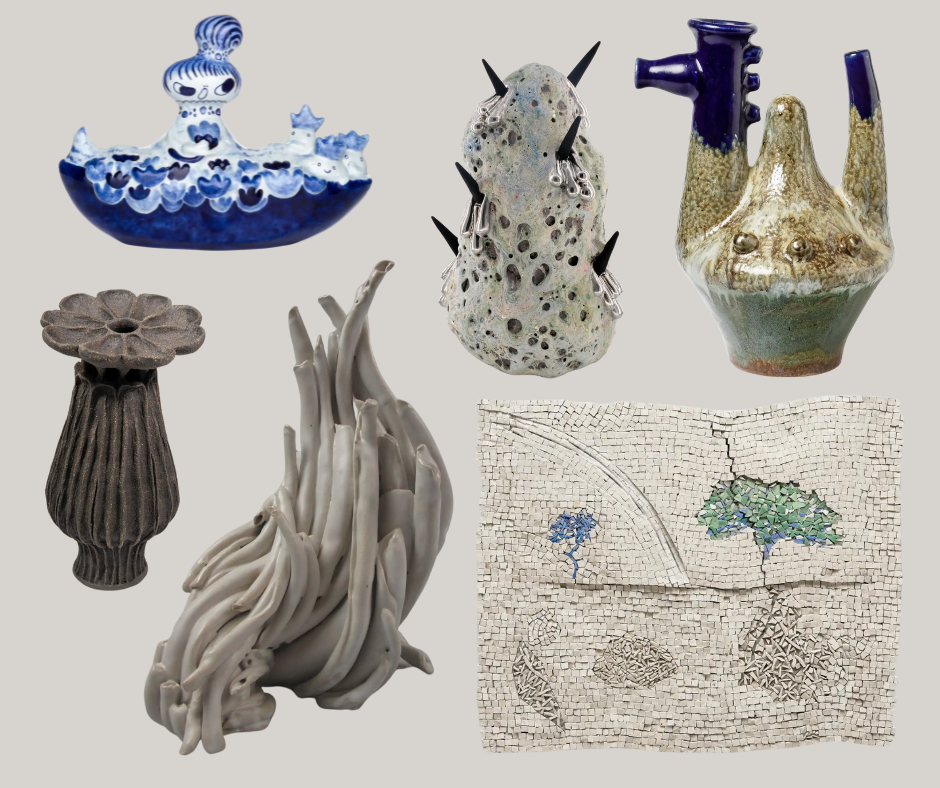
If you’re looking for bathroom artwork without the stress, ceramic and glass objects are your safest—and most stunning—bets. These materials are non-porous, structurally stable, and virtually immune to the warping, mold, and adhesive failure that plague works on paper or canvas. Hand-glazed ceramic reliefs, tile murals, or sculptural wall hangings add warmth and texture, especially when illuminated by natural or ambient light. Likewise, blown or fused glass pieces can bring a dreamy, luminous quality to the room without sacrificing durability.
Even vintage Murano-style wall sconces or minimalist glass discs can function as both art and light—casting gentle reflections that shift with time and steam. Unlike works on paper or wood, they won’t expand, contract, or degrade under fluctuating humidity. Just be sure they’re securely mounted and, if fragile or antique, kept out of splash zones.
Ceramic and glass objects allow you to indulge in the romance of bathroom decor without constantly worrying about deterioration. But remember, ceramics can be painted and the paint can separate from the substrate if prepared in certain ways. Still, in a space defined by water and heat, glass and ceramic are typically both the practical and poetic choice for bathroom art.
So, here are five ceramic sculptures you might consider for your powder bath or bathroom walls.
Fuel your creative fire & be a part of a supportive community that values how you love to live.
subscribe to our newsletter
*please check your Spam folder for the latest DesignDash Magazine issue immediately after subscription

Six Modern & Contemporary Ceramic Art Objects to Consider for Your Bathroom
Loren Kaplan – Black Poppyseed Capsule No. 3 (2024)
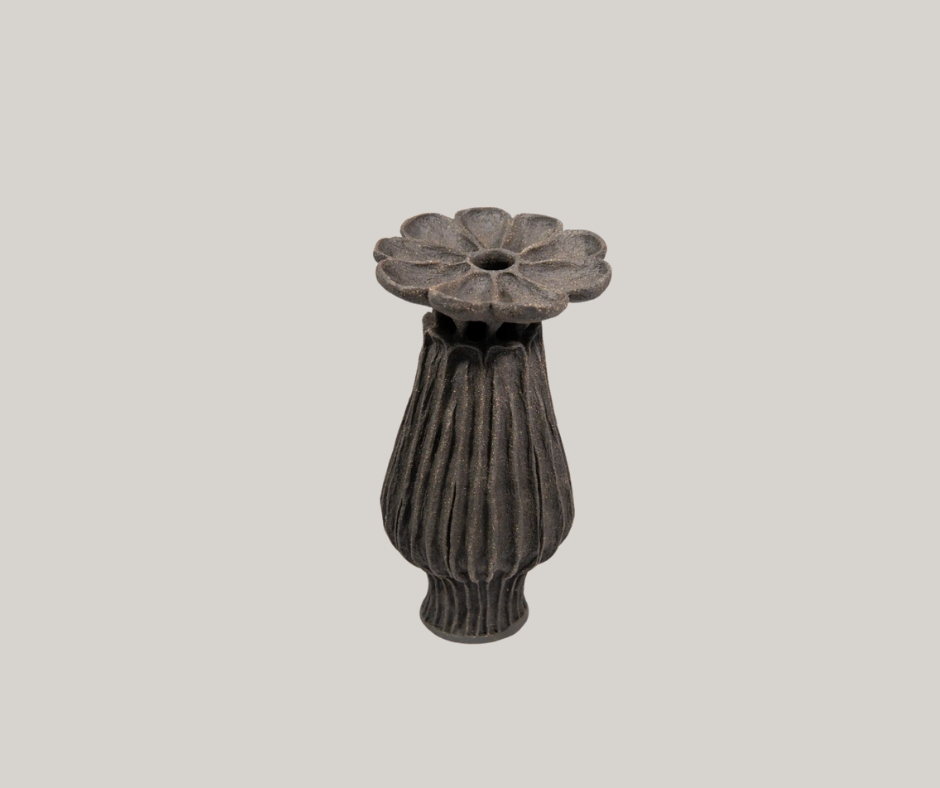
Hand-built in richly pigmented black clay, this sculptural vessel by Loren Kaplan reads like a botanical relic unearthed from another time. Its fluted, almost garment-like body blooms into a floral crown—part seedpod, part open flower. The form is inspired by the opium poppy, a plant long associated with transcendence and transformation, and its textural contrasts evoke the duality of containment and release.
At 15 inches tall, it’s striking enough to anchor a console but subtle enough to whisper. For Kaplan, a vessel is a meditation on space itself, and this piece carries that stillness beautifully into the bath.
Ayako Rokkaku – Untitled Royal Delft Ceramic Sculpture (2021)
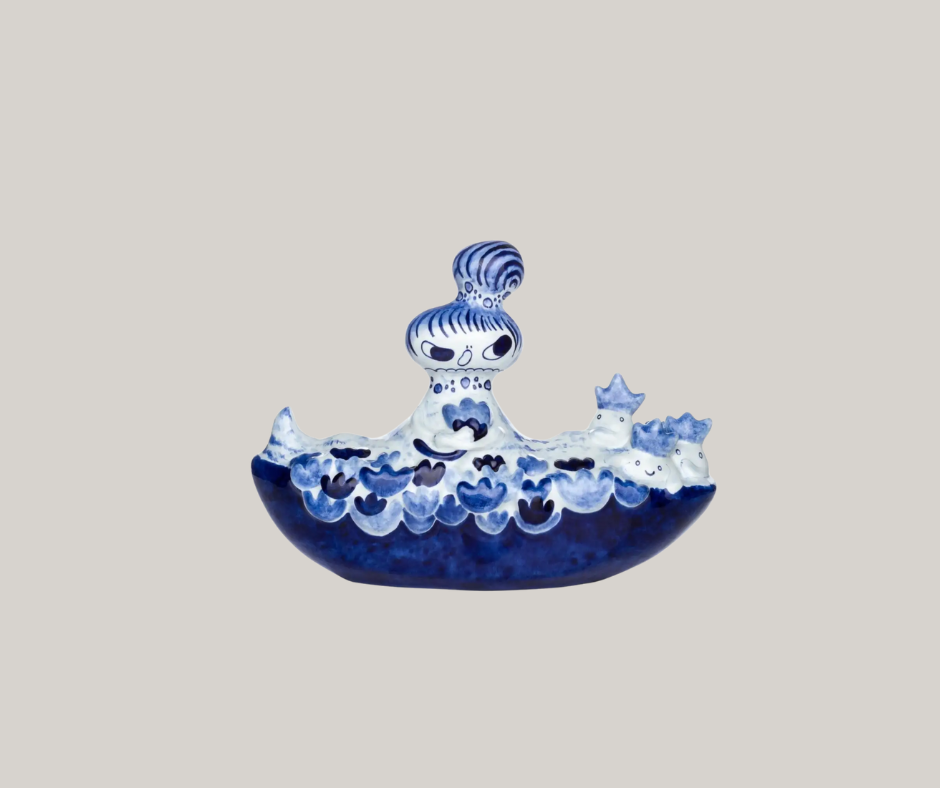
Bursting with the same playful spirit that defines her canvas work, Ayako Rokkaku’s hand-painted Delft ceramic sculpture translates her vibrant visual language into three dimensions. Though part of an edition of 200, each piece bears the unmistakable touch of the Japanese artist’s joyful chaos—cartoon-like figures, dreamlike color bursts, and her signature sense of spontaneity.
Rendered in glossy ceramic, it feels simultaneously contemporary and nostalgic, like a childhood memory cast in porcelain. Measuring just over 15 inches wide, it’s perfect for a powder bath shelf or niche, where its saturated palette and painterly surface can lift the energy of the entire room. It’s a moment of wonder—whimsical, but never trivial.
Sara Fine-Wilson – Turn (2017)
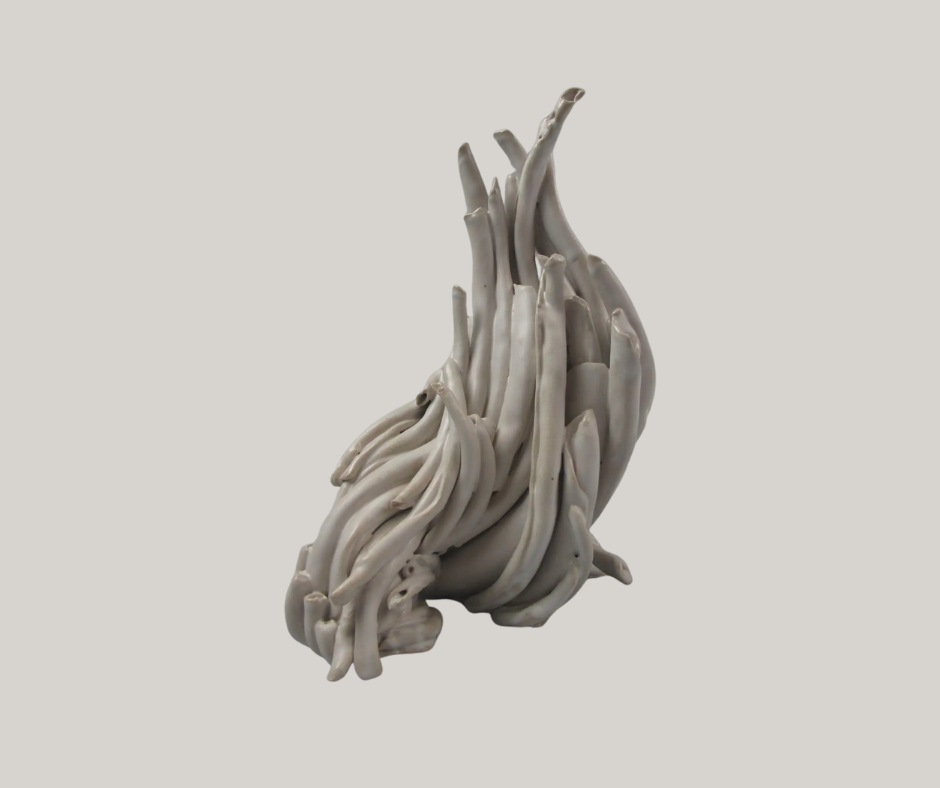
There’s a quiet intensity to Sara Fine-Wilson’s Turn, as if the clay itself is mid-breath. This gestural ceramic sculpture feels alive—its smooth, cream-colored tendrils twisting upward like sea kelp or unraveling ribbon. Composed of layered, individually formed elements, Turn explores the tension between fluidity and structure, instinct and form.
At just over 10 inches tall, its size is modest, but its presence is unmistakable. The mix of glossy and matte surfaces plays beautifully with ambient bathroom lighting, casting soft shadows and reflective highlights. Whether placed on a marble ledge or nestled into a niche, Turn doesn’t just decorate a space—it animates it.
Guerin – Zoomorphic Ceramic Sculpture Vase (c. 1950)
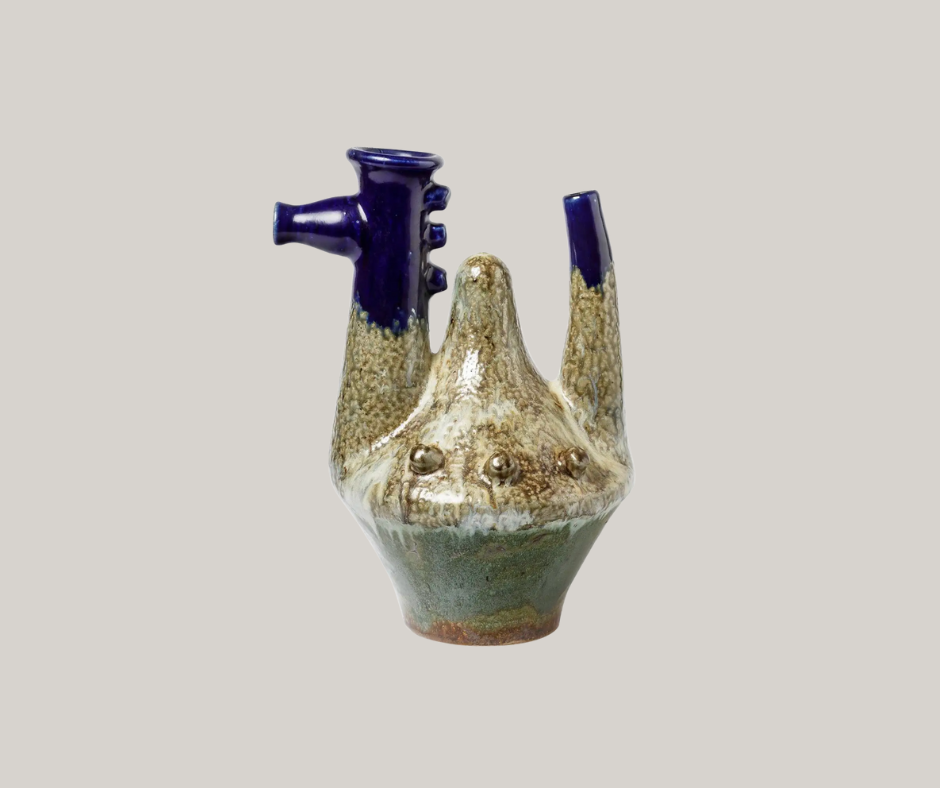
There’s a sense of myth and mystery embedded in this mid-century French ceramic by Guerin. With its horn-like appendages and textured glazes, the form borders on the fantastical—part vessel, part creature. The rich palette of moss green, weathered beige, and cobalt blue gives it the look of something pulled from the depths of a dream or an ancient hillside chapel.
Though sculptural in spirit, it was designed as a vase, offering function without compromising its artful soul. At over 15 inches tall, it brings vintage gravitas to a powder room—especially when placed solo on a stone vanity or open shelf where its shadow can dance along the wall.
Sasha Koozel Reibstein – Moon Wobble (2022)
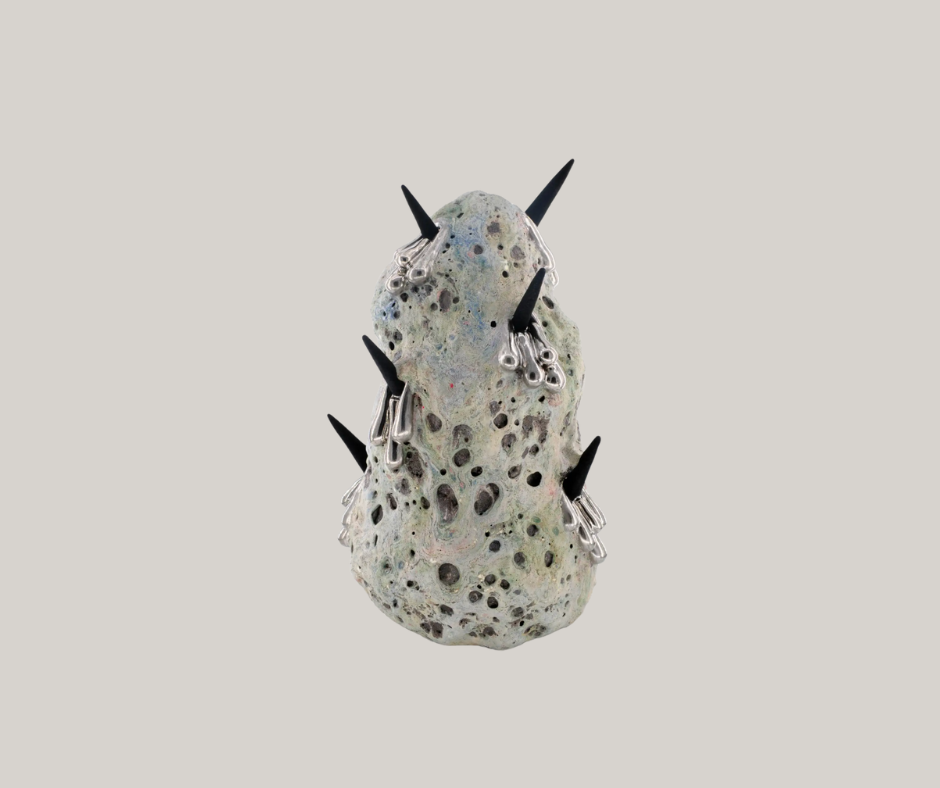
Moon Wobble is what happens when sculpture transcends the object and enters a dream state. Sasha Koozel Reibstein’s otherworldly ceramic—pocked like pumice, crowned with metallic drips, and pierced with obsidian-like spikes—feels both geological and galactic. The surface flickers with subtle luster, shifting color as light moves across it, while its biomorphic form hints at a life suspended mid-metamorphosis.
At 16 inches tall, it has the gravitas of a sacred relic and the edge of contemporary science fiction. Set it on a low shelf or countertop where you’d least expect it—this piece disrupts and redefines any space instead of merely inhabiting it.
Toyoharu Kii – Green Tree (2023)
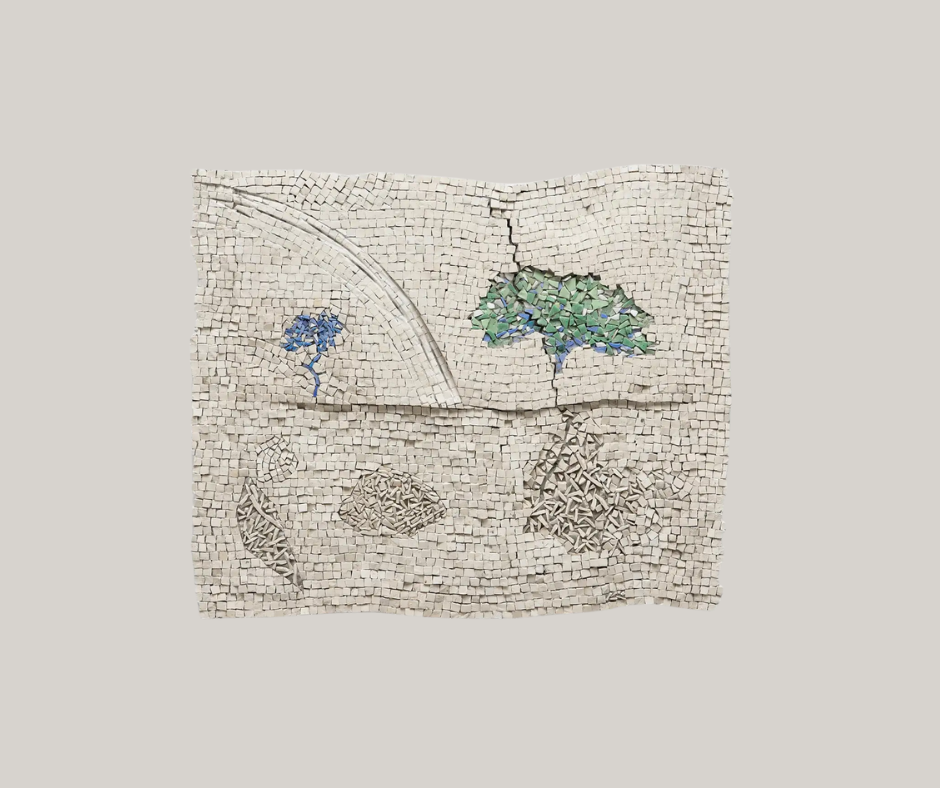
At once meditative and message-driven, Green Tree by Toyoharu Kii is a mosaic of extraordinary restraint. Composed of hand-cut Italian marble and smalti glass, this 17-inch-wide mixed-media work reflects the Japanese master’s commitment to both ancient technique and contemporary environmental storytelling.
The scene is stark: a pale, fissured expanse—scratched, fragmented, and devoid of color—except for two impossibly resilient trees. Their delicate leaves bloom in glimmers of green and blue, a visual whisper of regeneration in an otherwise damaged world. Hung on a powder room wall, this piece reads like a breath: quiet, composed, and full of life slowly reasserting itself. It’s art as renewal—subtle, symbolic, and deeply grounding.
Best Practices for Bath-Friendly Displays
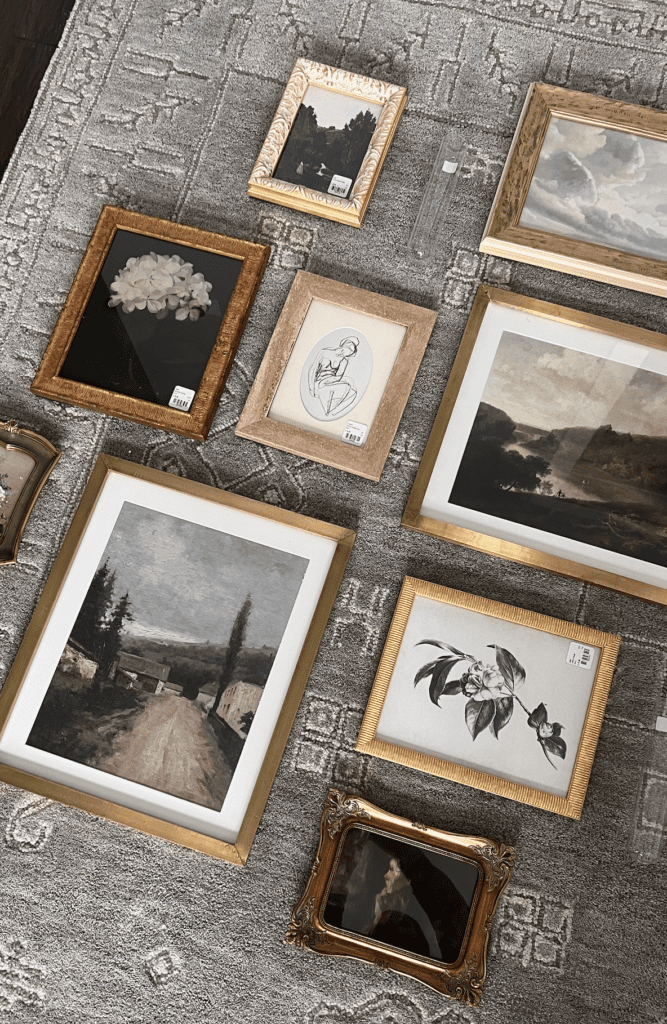
If you’re set on styling your bathroom with art, the key is to choose pieces and presentation methods designed to withstand a humid environment. Opt for professional framing with backing boards, moisture-resistant materials, and internal spacers that prevent the artwork from touching the glass.
Placement matters too: hang artwork far from the bathtub or shower. Avoid hanging your very favorite pieces near the medicine cabinet (which could swing open and damage the art), by the shower, above the toilet, or below any vents.
These are all the places that could cause problems for both sculptures and wall art. A good bathroom fan or dehumidifier can help regulate moisture levels. Consider rotating your pieces throughout the year, just as museums do with light-sensitive works, to minimize cumulative exposure.
And don’t overlook sculptural objects—ceramic reliefs, glass accents, or enamel wall pieces can make your bathroom feel textural and dramatic without the same vulnerability.




